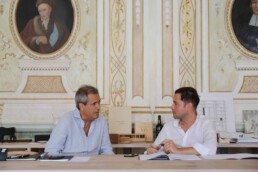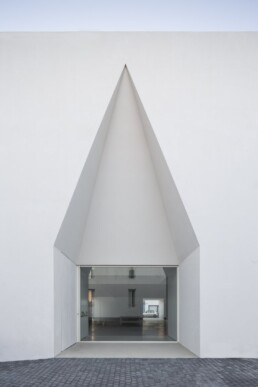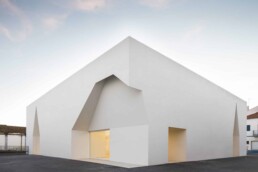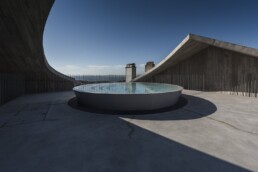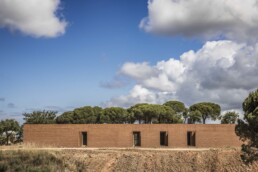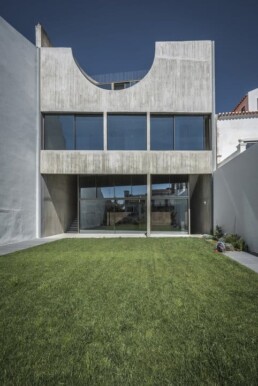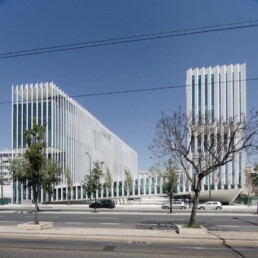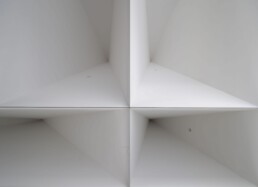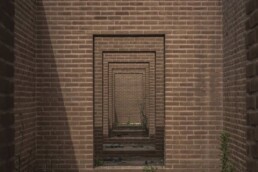Interview by Fran Silvestre with Manuel Aires Mateus for TC Cuadernos
DATE
02.02.2024
Manuel Aires Mateus: “Architecture is what remains, continues and remains in time.” Fran Silvestre interviews Manuel Aires Mateus for issue 145 of TC Cuadernos, where the Portuguese architect explains how he conceives the materialization of his architecture.
“Architecture is eternal art, it is what lasts, unlike design or fashion which are ephemeral, in the sense in which they change from one day to the next, which in its formulation the idea is to change. “Architecture is what remains, continues and remains in time.”
Manuel Aires Mateus.
Fran Silvestre: You have works made of brick, stone, concrete, wood, absolutely all materials. However, there is a question that everyone always asks: why are all the works white? What do you think it is due to?
Manuel Aires Mateus: I think it is something that is somewhat related to the idea that Lisbon is a white city, although in reality it is a place where each building is painted a different color. White is not white, it is a sum of all the colors there are. When people ask themselves that question, it is because since there are so many different things, in the end they last in memory as white. On the other hand, in reality, we do many works that end up being white, for reasons of climate, management, budget…
I am also interested in many cultural topics associated with white. On the one hand, white has many physical and real values such as reflection or the fact that it is an excellent conductor of light, or that it allows shapes to be seen more clearly. On the other hand, there are also many cultural values. Good is always associated with white. (…)
FS: Both in your teaching work and in your work there is a very clear Portuguese influence, but there is also a very important Swiss influence. When you sometimes try to extract a common factor from the Portuguese work, there is a very great power and an accentuation in terms of capturing space. (…) I have always been very curious to know what was introduced into the teaching of that Swiss culture.
MAM: More than a Swiss culture, it is a universal culture. We encounter two cultures, one local and one global, as two phenomena at the same time. This local-global struggle is very important and not only has to do with teaching. Portugal is a country with very strong traditions that come from the condition of very direct construction, almost like a centuries-old tradition of Portuguese architecture. This tradition has been very well translated by Álvaro Siza in a certain way, although we consider him a virtuoso of drawing, spatial construction and the idea of movement in space, which is very beautiful in his work as a whole. Siza is a bit of what he synthesizes and what interests us about the local culture.
And then, from global culture, there are many influences. There is a very strong influence from the Swiss, not from them in general, but from the early works of Herzog & de Meuron and the early works of Zumthor. (…)
“I think it is important to maintain and understand your origin, because doing so is part of understanding your individuality, because what is beautiful in the world are people, one by one.”
Manuel Aires Mateus
FS: Yes, it is very important, since you come into contact with many ideas. I think that a common factor in your work, and that it is a very notable capacity, is synthesis in projects. Many times there are ideas that are very sophisticated or sometimes you see that the works of other authors are contaminated or sprinkled with very heterogeneous things. However, from my point of view your work to a certain extent is also very pedagogical, but in its result, without even wanting to go to a classroom to explain anything, simply seeing it. It is interesting the ability to control these resignations from the project and know what to remove from it, knowing when it is finished. (…)
MAM: There is one thing you have to learn by talking about projects. Projects are a very long road, they take a long time, so the only thing you have to aim for at all times is to be clear and have clear ideas. This does not mean that you don’t have to change ideas, but every time we make a change, we have to return to a clear idea, which will no longer be the same, but it has to be clear. (…)
FS: A contribution that clarifies an aspect of great importance also stands out in your work. This is the width of the boundary. Working with space as an empty element that is contained by something that surrounds it is, on many occasions, a central point in your projects.(…) Is it something very conscious in the work or is it an obsession that is being taken to the extreme? .
MAM: It was an obsession when we were at the Venice Biennale in 2010. At that time we were very obsessed with this idea of the limit. Maybe even a little earlier. It is the result of a look at experience: when you think that architecture is not built without matter, the limit is material. Even if you use glass, it is no longer an absence, it is a presence. Therefore, architecture is built from matter, from the presence of materials. And of course, when you start thinking about that, you understand that if you can’t avoid matter, you have to use it. (…)
FS: At times, the important thing about projects can be the ideas built to last over time and not become obsolete. The material essence in some of these is the idea. (…)
MAM: This is very interesting, and I’ll explain why. [I am very clear about it.] For me, architecture is eternal art, it is what lasts, unlike design or fashion, which are ephemeral, in the sense in which they change from one day to the next, which in their formulation The idea is to change. Architecture is what remains, continues and remains in time. But in our heads the way we look at architecture has changed, the technology we use has changed. (…)
FS: There is one thing that I find very interesting about your work and that is the sense of recognition in it, understood from a much broader sense. That is, people recognize themselves in your works, students recognize themselves in your works. When you see a work you think that you could have done it or you would like to have done it yourself or it is an idea that at some point passed through your head although you did not materialize it, or you did not have the capacity, or the vision, to be able to do it.
MAM: I believe that many of the works we want to do are like things that are in the air. We look for them, but they are there. We look for them like many other people can look for them. We are aware that we make a synthesis that helps others see, because of course, we all take the path together, so we go searching and helping each other, and that in a certain sense works very well because we don’t need to force anything.
(…)
The complete interview with Fran Silvestre and his most recent work, available in the upcoming number 145 of TC Cuadernos. A tour of the photogenic and internationally acclaimed work of the Aires Mateus brothers with clear and rigorous project research.
MArch Valencia. Arquitectura y Diseño
© 2025 MArch Valencia. Arquitectura y Diseño
Privacy policy | Cookies policy | Terms of use
Interview by Fran Silvestre with Manuel Aires Mateus for TC Cuadernos



